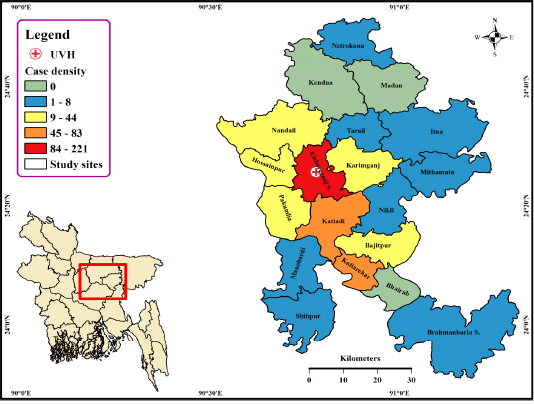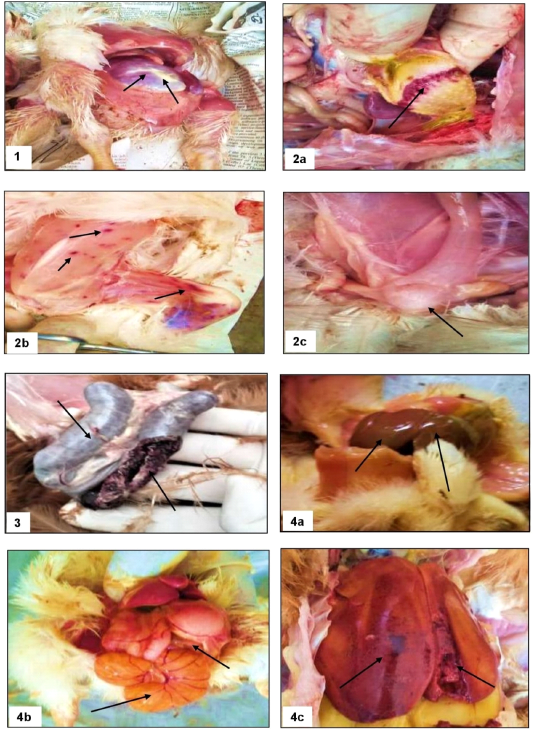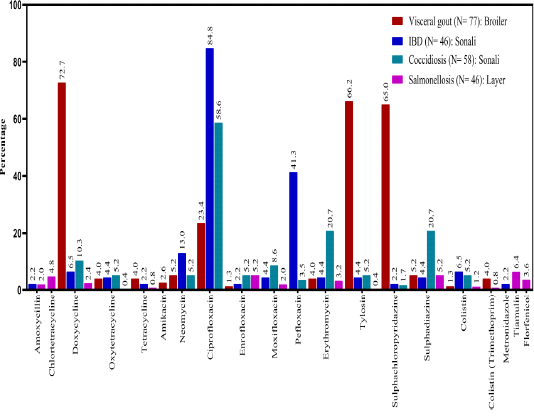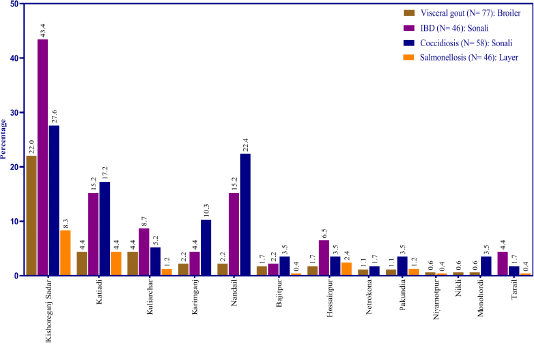Advances in Animal and Veterinary Sciences
Research Article
Common Chicken Diseases in Kishoreganj, Bangladesh: Estimation Through the Veterinary Hospital-Based Passive Surveillance System
Meherjan Islam1*, Shuvo Singha2, Joseph P. Belgrad3, F. M. Yasir Hasib4, Md. Abu Sayeed5,6, Md. Ershadul Haque7, Abdul Ahad8, Md. Ahasanul Hoque1
1Department of Medicine and Surgery, Chattogram Veterinary and Animal Sciences University, Chattogram-4225, Bangladesh; 2Department of Veterinary and Animal Sciences, University of Milan, Italy; 3Cummings School of Veterinary Medicine at Tufts, USA; 4Department of Pathology and Parasitology, Chattogram Veterinary and Animal Sciences University, Chattogram-4225, Bangladesh; 5EcoHealth Alliance, New York City, NY, USA; 6Institute of Epidemiology Disease Control and Research, Bangladesh; 7Department of Pharmacy, International Islamic University, Chattogram, Bangladesh; 8Department of Microbiology and Public Health, Chattogram Veterinary and Animal Sciences University, Chattogram-4225, Bangladesh.
Abstract | Poultry farming in South-East Asia has been rapidly progressing to meet the demands of population growth and reducing malnutrition. However, the diseases and the indiscriminate use of antibiotics in poultry threaten the industry posing public health risks. A clinico-epidemiological study was therefore conducted at the District Veterinary Hospital, Kishoreganj, Bangladesh during October-November 2019 to determine the overall disease prevalence, prescription patterns, and disease associated factors in different bird types. Data were obtained through interviews and inspections and then stored in MS Excel 2010. Data were coded, recorded, and checked for consistency before exporting to STATA-13 software for statistical analysis. ArcGIS Desktop Version 10.4.1 was used to produce a map showing geographical case distribution. In total, 552 cases (182 exotic broilers, 118 Sonali, and 252 exotic layers) were included during the study period. Visceral gout (42.4%), coccidiosis (49.2%), and colibacillosis (24.2%) were the most frequent disease in broiler, Sonali, and layers, respectively. The study also showed the single application of watch group antibiotics was the highest in broilers (88.3%), followed by Sonali (67.4%) and layers (56.5%). Doxycycline (72.7%) was the most common antibiotic for treating visceral gout in broilers, whereas ciprofloxacin was highly used in Sonali for infectious bursal disease (84.4%), and coccidiosis (58.6%) respectively, and tiamulin (6.4%) for salmonellosis in layers. This disease prevalence suggests poor farm hygiene and bio-security in the study areas. Special care should be taken around younger chickens’ as visceral gout and infectious bursal disease were the most common. Antibiotics should be used more judiciously to curb the growing multidrug resistance pattern among zoonotic bacteria.
Keywords | Chicken disease, Prevalence, Distribution, Antibiotic, Passive Surveillance
Received | August 14, 2021; Accepted | August 24, 2021; Published | September 25, 2021
*Correspondence | Meherjan Islam, Department of Medicine and Surgery, Chattogram Veterinary and Animal Sciences University, Chattogram-4225, Bangladesh; Email: meherjanislam@gmail.com
Citation | Islam M, Singha S, Belgrad JP, Hasib EMY, Sayeed MA, Haque ME, Ahad A, Hoque MA (2021). Common chicken diseases in kishoreganj, bangladesh: estimation through the veterinary hospital-based passive surveillance system. Adv. Anim. Vet. Sci. 9(11): 1951-1958.
DOI | http://dx.doi.org/10.17582/journal.aavs/2021/9.11.1951.1958
ISSN (Online) | 2307-8316; ISSN (Print) | 2309-3331
Copyright © 2021 Islam et al. This is an open access article distributed under the Creative Commons Attribution License, which permits unrestricted use, distribution, and reproduction in any medium, provided the original work is properly cited.
Introduction
South-East Asia is rapidly expanding its poultry production (Hellin et al., 2015). Globally, the United States ranked first in contributing about 18% to poultry meat production (FAO, 2021). China was the leading poultry meat producer in Asia supplying 14.5 million tons of chicken meat annually. India produced 4.2 million tons of chicken meat annually. At present, Bangladesh produced 0.2 tons of poultry meat annually, inflating the sector over the past two decades to 22% of total animal protein consumed (FAOSTAT, 2021).
The poultry industry has a low barrier to entry (Shamsuddoha and Sohel, 2004) with one million entrepreneurs and eight million people involved (Anon, 2020). By 2021, the country’s expected annual poultry requirements will be 17 billion eggs, 2 million tons of meat, and 85.8 million day-old-chicks (Anon, 2020). Every year, there is a 15% increase in poultry production (Hoque, M.A., personal communication, 2020). The current farm statistics in the study area are roughly 2,000 broiler farms, 500 Sonali farms, and 2,000 layer farms (Nuruzzaman, S.M., personal communication, 2020).
Disease, faulty biosecurity, and inadequate nutrition challenge the growing industry (Wong et al., 2017). Poor farm hygiene, bio-security, imperfect vaccine coverage, age, poultry strain, production type, flock size, floor type, farmers’ education, and experiences are closely associated with common poultry diseases (Meseret, 2016; Carrique-Mas et al., 2019). Veterinary hospital-based passive surveillance rarely investigates disease prevalence and associated factors.
Developing countries often over-rely on antibiotics for disease treatment (Ur Rahman and Mohsin, 2019). Antibiotics are readily available over the counters without a prescription (Haque et al., 2020) leading to indiscriminate use and antibiotic resistance (Oluwasile et al., 2014).
The Bangladesh poultry disease surveillance is poorly structured making antibiotic use patterns difficult to assess. Therefore, the present study reflects common poultry disease occurrences and antibiotic prescription patterns in the study area. The present study findings may apply to neighboring countries which have similar poultry production systems and hospital-based surveillance systems. The specific objectives of the study were ⅰ) to determine the overall disease and disease condition prevalence and distribution in different chicken types, ii) to identify factors associated with predominant diseases, and ⅲ) to assess antibiotic prescription patterns against common chicken diseases.
Materials and methods
Study location and duration
The author completed a 34-day clinical rotation internship at the Kishoreganj District Veterinary Hospital (KDVH) between the 13 October to 27 of November 2019. Therefore, this research was conducted at KDVH, one of the primary hospitals in Bangladesh for handling poultry cases.
Study design and cases
We used 552 chicken cases for this study. Case distribution was 182 exotic broilers, 118 Sonali broilers, and 252 exotic layers. Figure 1 shows case spatial distribution.

Figure 1: Map showing the case distribution (552 poultry cases) presented in Kishoreganj District Veterinary Hospital, Bangladesh during (13 October to 27 November, 2019)
Registered poultry veterinarians diagnosed cases through clinical signs and pathognomonic lesions. This manuscript focused primarily on Visceral gout (VG) in exotic broilers, infectious bursal disease (IBD) and coccidiosis in Sonali, and salmonellosis in layers.
Recording of clinical and epidemiological data
Clinical and post-mortem (PM) examinations were conducted for each case. Findings from each case were recorded in a structured record-keeping sheet. Figure 2 shows lesions from focused cases.
Data included farmers’ education and experience, poultry species, production type (broiler/Sonali (meat-type)/layer), farm’s location, farm size, floor type, birds’ age, clinical history, clinical signs, morbidity and mortality, observable post-mortem findings, tentative diagnosis, and prescribed drugs (Hannan et al., 2020). Antibiotic prescription data was also included in this study. Before conducting the data collection procedure, an oral permission was taken from
Table 1: Commercial poultry disease and disease condition distribution (N=182 exotic broiler, 118 Sonali and 252 exotic layer cases) in Kishoreganj, Bangladesh (13 October to 27 November, 2019) [Frequency number of cases (concurrent diseases or disease conditions in individual cases) were counted individually.]
| Group | Disease or disease conditions | Exotic broiler, n(%) | Sonali, n(%) | Exotic layer, n (%) |
| Viral | Infectious bursal disease | 46 (25.3) | 46 (39.0) | 9 (3.6) |
| Newcastle disease | 3 (1.7) | 6 (5.1) | 49 (19.4) | |
| Avian influenza | 2 (1.1) | 1 (0.9) | 5 (1.98) | |
| Chicken infectious anemia | 2 (1.1) | 3 (1.2) | ||
| Avian leucosis | 2 (0.8) | |||
| Infectious bronchitis | 2 (0.8) | |||
| Marek’s disease | 1 (0.4) | |||
| Bacterial | Complex respiratory disease | 41 (22.5) | 7 (6.0) | 23 (9.1) |
| Colibacillosis | 28 (15.4) | 16 (13.6) | 61(24.2) | |
| Salmonellosis | 12 (6.6) | 9 (7.6) | 46(18.3) | |
| Fowl cholera | 1 (0.6) | 1 (0.9) | 11(4.4) | |
| Infectious coryza | 1 (0.9) | 4(1.6) | ||
| Necrotic enteritis | 3(1.2) | |||
| Tuberculosis | 1(0.4) | |||
| Others | Visceral gout | 77 (42.4) | 9 (7.6) | 4(1.6) |
| Coccidiosis | 18 (10.0) | 58 (49.2) | 15(6.0) | |
| Management problem* | 2 (1.1) | 2 (1.7) | 1(0.4) | |
| Heat stress | 2 (1.1) | 24(9.5) | ||
| Aspergillosis | 1 (0.6) | |||
| Giardiasis | 1(0.6) | |||
| Ascites | 1(0.6) | |||
| Common cold | 2 (1.7) | |||
| Nutritional disease** | 3 (1.1) | |||
| Aflatoxicosis | 2 (0.8) | |||
| Low egg production | 20 (8.0) |
*Lighting problem, Brooder pneumonia; **Vit B1 & B2 deficiency, Ca deficiency, Fatty liver syndrome
the District Livestock Officer of the Veterinary Hospital and also the oral consent was taken from the participated poultry farmers.
Case definition of focused cases
Visceral gout: An individual chicken case with a history of decreased feed intake and body weight (Mudasir et al., 2017) with uric acid deposition in the visceral organs (e.g., heart, the serosal surface of the pericardium, air sacs, intestine, kidney, liver), pericarditis, and perihepatitis (Lakshmi Namratha et al., 2019).
Infectious Bursal Disease: An individual chicken case with a history of dullness, and sudden death (Orakpoghenor et al., 2020). Lesions included an enlarged bursa of fabricius, thymus, spleen, and kidney. Later, the bursa of fabricius and thymus became atrophic with pus and hemorrhagic lesions on the bursa of fabricius and pectoral and thigh muscles (Sali, 2019).
Coccidiosis: An individual chicken case with bloody diarrhea, decreased feed intake, and body weight (Hamid et al., 2018). Other lesions included clotted blood (fresh or congested) masses in the lumen of the caecum (Sharma et al., 2015).
Salmonellosis: An individual case with a history of dullness, watery diarrhea, decreased feed intake and egg production, and death (Akhtaruzzaman et al., 2020). Other lesions included fragile liver with multiple white focal-necroses, bronze-colored liver, congested and hemorrhagic liver, congested ova, and stalky ova (Sarker et al., 2019).
Statistical analysis
Data were entered into Microsoft Excel 2010. After coding and re-coding, data were checked for integrity and consistency, then entered into STATA 13 (Stata Crop, 4905, Lakeway Drive, College Station, Texas 77845, USA) for statistical analysis. We calculated prevalence by taking

Figure 2: Post-mortem findings of the predominant diseases: 1 Deposition of urate crystals in the serous membrane of the heart. 2a Haemorrhage at the junction of proventriculus and gizzard. 2b Ecchymotic hemorrhage in leg muscle and pectoral muscle. 2c Swollen bursa of fabricius. 3 Dark clotted blood mass in ceca 4a Fragile bronze-colored liver in chick. 4b Omphalitis and typhlitis in chick. 4c Enlarged and fragile liver with congestion and grayish necrotic foci Visceral gout (broiler) (1), Infectious bursal disease (Sonali) (2), Coccidiosis (Sonali) (3), Salmonellosis (layer) (4)
the number of individual cases divided by the total cases according to poultry type and the other recorded factors. Antibiotic/sulfa drug data underwent descriptive analysis.
We applied Fisher’s exact test to assess the difference of proportion of each case type (for example, VG/IBD/Coccidiosis/Salmonellosis, yes/no) between or among each factor (location, flock size, age, floor type, farmers’ education, and experience) in the study. We expressed the results in terms of frequency numbers, percentages, and p-values. We determined significance using a p-value of ≤ 0.05.
Results
Distribution of poultry cases by a group of diseases or disease conditions
This study estimated a wide range of poultry diseases and disease conditions (Table 1). Among viral diseases, IBD cases were the most common in broilers (25.3%), and Sonali (39.0%). Newcastle Disease was more frequent in layers (19.4%). Among bacterial diseases, colibacillosis was the most frequent in broilers (15.4%), Sonali (13.6%), and layers (24.2%). Salmonellosis was also dominant in layers (18.3%). Among other diseases, VG was the most frequent in broilers (42.4%). Coccidiosis was the most prevalent in Sonali (49.2%). Heat stress was the most frequent in layers (9.5%) (Table 1).
Spatial distribution of four predominant types of poultry cases
Figure 3 presents poultry case geographical origin. VG cases in broilers originated mostly from Kishoreganj Sadar (KS) (22%) followed by Katiadi and Kuliarchar (4.4% each). IBD cases in Sonali predominantly originated from KS (43.4%), Katiadi (15.2%), and Nandail (15.2%). Coccidiosis cases mostly originated from KS (27.6%), Nandail (22.4%), and Katiadi (17.2%). Salmonellosis cases were the most frequent from KS (8.3%), Katiadi (4.4%), and Hossainpur (2.4%) (Figure 3).
Association between the response variable (visceral gout/infectious bursal disease/ coccidiosis/salmonellosis) and independent variables
VG prevalence was significantly higher in younger broilers (3-13days) (55.6%) than adult broilers (41.6%) (p = 0.001) (Table 2). IBD prevalence in Sonali was significantly greater in ages 17-40 days (52.2%) compared with 41-56 days (17.7%) and 2-26 days (22.0%) (p=0.02) (Table 2). No factor was significantly associated with coccidiosis and Salmonellosis prevalence in layers (Table 2).
Antibiotic prescription pattern against visceral gout, Infectious Bursal Disease, coccidiosis, and salmonellosis
WHO watch group antibiotics were mostly prescribed singly against VG (88.3%), IBD (67.4%), coccidiosis (67.2%), and salmonellosis (56.5%) (Table 3). Single access-group antibiotics were prescribed in the following frequency: VG (11.7%), IBD (11.0%), coccidiosis (10.3%), and salmonellosis (30.4%) (Table 3). Reserve group antibiotics were prescribed in the following frequency: VG (5.2%), IBD (6.5%), coccidiosis (5.2%), and salmonellosis (8.7%) (Table 3).
Table 2: Association among visceral gout (N=77 exotic broiler cases)/infectious bursal disease (N= 46 Sonali cases)/ coccidiosis (N=58 Sonali cases)/salmonellosis (N=46 exotic layer cases) and potential factors in Kishoreganj, Bangladesh (13 October to 27 November, 2019)
|
Factors |
Broiler | Sonali | Layer | ||||
| Visceral gout | Infectious bursal disease | Coccidiosis | Salmonellosis | ||||
| Categories | N | Categories | N | N | Categories | N | |
| Age (days) | 3-13 | 40 (55.6) | 2-16 | 7 (22.0) | 12 (37.5) | 2-180 | 14 (16.3) |
| 14-25 | 37 (41.6) | 17-40 | 36 (52.2) | 38 (55.1) | 181-350 | 19 (16.8) | |
| 26-55 | 41-56 | 3 (17.7) | 8 (47.1) | 351-672 | 13 (24.5) | ||
| Flock size | 600-1050 | 40 (46.5) | 750-2000 | 29 (38.7) | 35 (46.7) | 201-1200 | 29 (19.0) |
| 1051-9000 | 37 (38.5) | 2001-9000 | 17 (39.5) | 23 (53.5) | 1201-5500 | 17 (17.2) | |
| Floor type | Earthen floor | 52 (41.4) | Earthen floor | 33 (38.8) | 39 (46.0) | Earthen floor | 25 (17.0) |
| Paved floor | 26 (46.4) | Paved floor | 13 (40.0) | 19 (57.6) | Paved floor | 21 (20.0) | |
| Education | Primary | 37 (41.6) | Primary | 22 (43.1) | 28 (55.0) | Primary | 11 (15.1) |
| Secondary | 25 (44.0) | Secondary | 15 (41.7) | 18 (50.0) | Secondary | 14 (9.4) | |
| Higher | 15 (41.7) | Higher | 9 (29.0) | 12 (38.7) | Higher | 21 (19.6) | |
| Experience (years) | 0-2 | 52 (43.3) | 1-2 | 36 (38.7) | 44 (47.3) | 0-2.5 | 16 (17.1) |
| 2.5-12 | 25 (40.3) | 2.5-5 | 10 (40.0) | 14 (56.0) | 2.6-5.5 | 20 (20.0) | |
| 5.6-14 |
12 (19.7) |
||||||
Table 3: Distribution of antibiotics/sulphur drugs prescribed against visceral gout (N=77 exotic broiler cases) and infectious bursal disease (N=46 Sonali cases), coccidiosis (N=58 Sonali cases) and salmonellosis (N=46 exotic layer cases) in commercial poultry in Kishoreganj, Bangladesh (13 October to 27 November, 2019)
| Species/ Strain | Disease | Antibiotics prescribed | Access, n(%) | Watch, n(%) | Reserve, n(%) |
| Broiler | Visceral gout | Single | 9(11.7) | 68(88.3) | 4(5.2) |
| Double | 3(4.0) | 4(5.2) | 0 | ||
| Multiple | 50(65.0) | 0 | 0 | ||
| None | 15(99.5) | 5(6.5) | 73(94.8) | ||
| Sonali |
Infectious bursal disease |
Single | 5(11.0) | 31(67.4) | 3(6.5) |
| Double | 7(15.2) | 9(19.6) | 0 | ||
| Multiple | 6(13.0) | 0 | 0 | ||
| None | 28(61.0) | 6(13.0) |
43(93.5) |
||
| Sonali | Coccidiosis | Single | 6(10.3) | 39(67.2) | 3(5.2) |
| Double | 8(13.8) | 9(15.5) | 0 | ||
| Multiple | 16(27.6) | 0 | 0 | ||
| None | 28(48.3) | 10(17.2) | 55(94.8) | ||
| Layer | Salmonellosis | Single | 14(30.4) | 26(56.5) | 4(8.7) |
| Double | 5(11.0) | 6(13.0) | 0 | ||
| Multiple | 14(30.4) | 0 | 0 | ||
| None | 13(28.3) | 14(30.4) |
42(91.3) |
Access: Amoxycillin, Florfenicol, Doxycycline, Tetracycline, Oxytetracycline, Chlortetracycline,
Watch: Ciprofloxacin, Enrofloxacin, Moxifloxacin, Pefloxacin, Flumequine, Erythromycin, Tiamulin, Sulphadimidine and Trimethoprim combination, Sulphadiazine and Trimethoprim combination, Sulphachloropyridazine and Trimethoprim
Reserve: Colistin.
Doxycycline (72.7%), Tylosin (66.2%), and sulphachloropyridazine and trimethoprim together (65%) were frequently prescribed against VG (Figure 4). Ciprofloxacin (84.8%) and pefloxacin (41.3%) were frequently prescribed against IBD (Figure 4). In coccidiosis, ciprofloxacin (58.6%) and erythromycin (20.7%) were frequently used (Figure 4). Tiamulin (6.4%), Sulphachloropyridazine, and trimethoprim together (5.2%) and enrofloxacin (5.2%) were frequently prescribed against salmonellosis (Figure 4).

Figure 3: Spatial distribution of important poultry diseases (visceral gout, infectious bursal disease, coccidiosis, and salmonellosis) in Kishoreganj, Bangladesh during 13 October to 27 November, 2019

Figure 4: Distribution of different types of antibiotics prescribed in visceral gout (N=77 broiler cases), infectious bursal disease (N=46 Sonali cases), coccidiosis (N=58 Sonali cases) and salmonellosis (N=46 layer cases) in commercial poultry in Kishoreganj, Bangladesh (13 October to 27 November, 2019) [Frequency numbers of antimicrobials (multiple antimicrobials in individual cases) were counted individually.]
Discussion
Proper disease surveillance programs are keys in assessing disease burdens and developing policy and control strategies. This study used the veterinary hospital-based passive surveillance data on poultry diseases and drugs recording a wide range of diseases and disease conditions (25), and prescription patterns for different production types. The disease types and prevalence presented in this study have been previously reported in Bangladesh (Rahman et al., 2019).
Our study showed IBD prevalence in broilers and Sonali of 25.3 and 39.0% respectively, and ND prevalence in layers of 19.4%. These estimates have been confirmed in previous Bangladesh studies (Hassan et al., 2016; Munmun et al., 2016). Poor farm bio-security, non-vaccination, and sub-par vaccination protocols may all contribute to these estimates (Sharif and Ahmad, 2018). IBD prevalence was significantly greater in Sonali ages 17-40 days (52.2%) (Table 2) as documented by (Teshome et al., 2015) in the broiler.
In this study, colibacillosis, a bacterial disease, was prominent in broilers, Sonali, and layers (13.6-24.2%) (Table 1). Salmonellosis was common in layers (18.3%) (Table 1), similar to previous Bangladesh studies. Small and medium-scale farms typically have poor hygiene and farm bio-security practices (Badruzzaman et al., 2015; Matin et al., 2017). Rats, the carrier of Salmonella spp. and E. Coli, are also common on these farms (Høg et al., 2019).
Our data, supported by (Talukdar et al., 2017), showed that coccidiosis was frequent in Sonali (49.2%) (Table 1), further indicative of poor hygienic practices. VG was more prevalent in broilers (42.4%) of 3-13 days (55.6%) (Table 1 and Table 2). The Indian study, (Yadav et al., 2020) supports these findings. Predisposing factors for VG are excessive calcium and protein intake, vitamin A and phosphorus deficiency, concurrent diseases, diclofenac, mycotoxins, and cold seasons (Singh et al., 2013).
KS had the highest frequency of VG (broiler), IBD and coccidiosis (Sonali), and salmonellosis (layer). This is likely due to the high poultry farm density (N~520) compared with surrounding regions (N~350) (Jahan, S., personal communication, 2020).
Indiscriminate antibiotic use is common in Bangladesh (Khan et al., 2018). As shown in Table 3 veterinarians prescribed access, watch, and reserve group antibiotics frequently. Antibiotics were even prescribed for VG, a non-bacterial disease (Acharya and Wilson, 2019).
Figure 4 shows that doxycycline, tylosin, and sulphachloropyridazine, and trimethoprim together were prescribed against broiler VG cases.VG cases coincide with viral diseases like infectious bronchitis, avian nephritis, and chicken astrovirus disease (Bulbule et al., 2014). Antibiotics are still ineffective in these cases.
As IBD is a viral disease, ciprofloxacin and pefloxacin application (Figure 4) is contraindicated, yet the antibiotics are frequently prescribed in Bangladesh (Sayeed et al., 2020). Common drugs for coccidiosis in poultry are sulfaquinoxaline, amprolium, quinolones, and ionophores (Ahmad et al., 2016). However, the present study recorded ciprofloxacin and erythromycin use (Figure 4) against Coccidiosis to check the secondary bacterial infection. Coccidiosis occurrs frequently with IBD possibly due to IBD’s immunosuppressive effects (Akhtar et al., 2015).
Tiamulin, sulphachloropyridazine and trimethoprim, and enrofloxacin were prescribed most frequently for Salmonellosis (Figure 4). This study recorded 14 different types of antibiotics/sulfa drugs prescribed against various cases of Salmonellosis at this hospital. The hospital has no set protocol for drug administration and is using the drugs indiscriminately.
Continued indiscriminate antibiotic use will lead to a post-antibiotic era (Luepke et al., 2017) in which antibiotics are no longer effective in treating bacterial infections (Hameed et al., 2016). Farmers rarely follow medical advice and give both sick and healthy poultry antibiotics on a regular basis due to the difficulty in separating sick from healthy birds (Bhushan et al., 2017). Still, this practice poses a serious public health risk and should be thoroughly addressed with farmers (Zaman et al., 2017).
Conclusion
This study gives baseline data and knowledge about common poultry diseases, disease conditions, disease distribution, management practices, and antibiotic prescription patterns. Proper farm management practices are either unknown to farmers or are not implemented. More poultry farm management and antibiotic use training programmes should be offered to poultry farmers in the study areas and surrounding areas.
Acknowledgments
The authors are grateful to the District Livestock Officer, and Veterinary Surgeon, Kishoreganj District Veterinary Hospital, Kishoreganj, Bangladesh for their cooperation and assistance in conducting the research.
Authors’ contribution
MI with the help of MAH and AA developed the study objectives and methodology. MI did the fieldwork. MI with the help of MAH did the data analysis and interpretation. GIS map was constructed by MAS. MI prepared the first draft with the help of MAH, FMYH, MAS, MEH and AA. MAH and AA supervised the research work and reviewed the manuscript. JB critically reviewed and edited the script.
Conflicts of Interest
The authors declare no conflict of interest.
References






